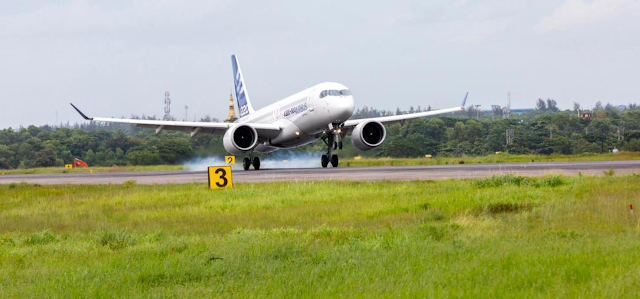Sources:
AIRBUS
Getting to grips with aircraft performance. Jan 2002.
Michel PALOMEQUE
A320 Flight Safety Director & Chief Engineer Advisor A320 Program
Safety first #06 July 2008
LORRAINE DE BAUDUS
Flight Operations Standards & Safety management
PHILIPPE CASTAIGNS
Experimental Test Pilot
Stéphane PUIG
Project Leader, Safety Initiatives
Engineering
24th Flight Safety Conference
19-22 March 2018
Vienna, Republic of Austria
Safety first - Special Edition - February 2018
“disrespecting” the V1 speed - implications
of not respecting V1
a)
The
crew decides to continue take-off while an engine failure occurred before V1.
The aircraft can potentially exit
the runway laterally, or be unable to take-off before the end of the runway.
b)
An
RTO is initiated above V1.
GO/
NO GO decision prior to the aircraft reaching V1.
After V1, the crew must continue take-off and consider using TOGA thrust except if a derated take-off was performed.
What speeds exactly should be monitored?
What do these speeds
mean and where do they come from?
What happens if such
speeds are exceeded?
V1: Decision speed
V1 is the maximum speed at which a
rejected take-off can be initiated in the event of an emergency.
V1 is also the minimum speed at
which a pilot can continue take-off following an engine failure.
VMBE = Maximum Brake Energy speed.
The ground speed at which maximum
energy is put into the brakes, when a RTO is performed at MTOW.
V1 must be lower than VMBE.
This speed is entered by the crew in the MCDU during flight preparation, and it is represented by a “1” on the speed scale of the PFD during take-off acceleration.
If
take-off is aborted at V1, the aircraft must be able to come
stopped before the end of the runway, without exceeding the maximum energy the
brakes can absorb.
If an
engine failure occurs after V1, then the aircraft must be able to
achieve a safe take-off with TOGA or derated power (enough lateral control).
The
minimum speed during take-off roll at which the aircraft can still be controlled
after a sudden failure of one engine (be it a two or four-engine airplane).
If the
take-off is continued, only the rudder will be able to counteract the
yaw moment that is generated by asymmetric engine(s) thrust.
VMCG = Minimum Control Speed
on the Ground
It is the
limit speed determined during Airbus flight tests.
If a
failure occurs before reaching this
minimum speed, the takeoff must be interrupted to maintain control of
the aircraft.
V1 must
be greater than VMCG.
VEF = Engine Failure Speed
The
maximum aircraft speed at which the most
critical engine can fail without compromising the safe completion of take-off
after failure recognition.
V1 must
be greater than VEF.
Considering
that it is generally assumed humans have a reaction time to an unexpected event
(such as a failure) of 1 second.
VEF must
be greater than VMCG.
If an
engine failure happens at VEF, then it
must be possible to continue and achieve the safe take-off speed with TOGA
power triggered.
Minimum Control Speed on the Ground: VMCG
In the determination
of VMCG, assuming that the path of the airplane accelerating
with all engines
operating is along the centerline of the runway, its path from the point
at which the
critical engine is made inoperative to the point at which recovery to a
direction parallel
to the centerline is completed, may not deviate more than 30 ft
laterally from the centerline
at any point.”
V2: Take-off safety
speed
V2 is the minimum take-off speed that the aircraft must attain by 35 feet above the runway surface with one engine failed at VEF and maintain during the second segment of the take-off.
This speed must be entered by the crew during flight preparation and is represented
by a magenta triangle on the PFD speed scale.
V2 is always greater
than VMCA and facilitates control of the aircraft in flight.
What are the operational implications of not respecting V2?
Supposedly, there
are two different ways of “disrespecting” the V2 speed criteria:
1. Flying below V2
in case of an engine failure.
The drag increase
below V2 may lead to a situation where the only way to recover speed is to
descend.
If the speed further
decreases and V2 is not recovered, then the high angle of attack protection may
be reached, and the aircraft may ultimately enter into an unrecoverable descend
trend. In particular, if the speed decreases below VMCA, the aircraft might not
be recoverable due to lack of lateral control.
2. Flying above V2
in case of an engine failure.
In case of excessive
speed, the required climb performance may not be reached, thus increasing the
chance to trespass the obstacle clearance.
Minimum Control Speed in the Air: VMCA
VMC[A] may not
exceed 1.2 VS with
• Maximum available
take-off power or thrust on the engines;
• The most unfavorable
center of gravity;
• The airplane
trimmed for take-off;
• The maximum
sea-level take-off weight
• The airplane in
the most critical take-off configuration existing along the flight path after
the airplane becomes airborne, except with the landing gear retracted; and
• The airplane
airborne and the ground effect negligible
Minimum Control Speed during Approach and Landing: VMCL
The minimum control
speed during approach and landing with all engines operating, is the calibrated
airspeed at which, when the critical engine is suddenly made inoperative, it is
possible to maintain control of the airplane with that engine still
inoperative, and maintain straight flight with an angle of bank of not more
than 5º.
VMCL must be
established with:
• The airplane in
the most critical configuration (or, at the option of the applicant, each
configuration) for approach and landing with all engines operating;
• The most unfavorable
center of gravity;
• The airplane
trimmed for approach with all engines operating;
• The most unfavorable
weight, or, at the option of the applicant, as a function of weight.
• Go-around thrust
setting on the operating engines
Minimum Unstick Speed: VMU
It is the calibrated
airspeed at and above which the airplane can safely lift off
the ground, and
continue the take-off…”
During the flight
test demonstration, at a low speed (80 - 100 kt), the pilot pulls
the control stick to
the limit of the aerodynamic efficiency of the control surfaces. The
aircraft
accomplishes a slow rotation to an angle of attack at which the maximum lift
coefficient is
reached, or, for geometrically-limited aircraft, until the tail strikes the
runway (the tail is
protected by a dragging device). Afterwards, the pitch is
maintained until
lift-off.
Two minimum unstick
speeds must be determined and validated by flight tests:
- with all engines
operatives : VMU (N)
- with one engine
inoperative : VMU (N-1)
In the one-engine
inoperative case, VMU (N-1) must ensure a safe lateral control
to prevent the
engine from striking the ground.
Typical tailstrike scenario
Most of the
tailstrikes on A320 family aircraft occur during
landing in manual mode (Auto Pilot OFF),
when the sidestick is maintained in the aft position after touch down.
Additional alerts to impeding tailstrike
• A pitch limit
indicator on the Primary Flight Display, which is displayed at landing (below
400 feet AGL in both manual and automatic modes) when the thrust levers are
below the FLEX/MCT setting.
• A “PITCH, PITCH”
call out, activated when the pitch is greater than a certain threshold and if
TOGA is not selected.
(The call out is
available on the following standards : FWC H2F3 or H2F3P and FAC 618 or 619).
Managed Descent
The managed descent
mode guides the aircraft along the FMS computed vertical flight path. The mode is preferred when conditions permit since
it ensures the management of altitude constraints and reduces the operating
cost when flying at ECON DES speed. The
mode is only available when the aircraft flies
on the FMS lateral flight plan, i.e. when the aircraft uses the
horizontal guidance mode.
MANAGING SPEED DURING APPROACH AND LANDING
In a decelerated
approach, the aircraft is decelerating during its final approach segment to be
stabilized at VAPP at 1000ft above the airport elevation. In most cases, it
reaches the Final Descent Point
(FDP) in CONF1 at S
speed. However, in some cases, when the deceleration capabilities are low (e.g.
heavy aircraft, a high elevation airport or tailwind), or for particular
approaches with a deceleration segment located at low height, the flight crew
should select CONF 2 before the FDP. The FCOM recommends selecting CONF 2
before the FDP when the interception of the final approach segment is below
2000ft AGL (A320) or 2500ft AGL (A330/A340, A350 and A380). In this case, for
ILS, MLS or GLS approaches, or when using FLS guidance, it is good practice to
select FLAPS 2 when one dot below the glideslope on the PFD deviation scale.
The take-off
preparation by the pilots entails the computation of the aircraft weights (Zero
Fuel Weight, Take-Off Weight) and respective CG positions, as well as the
calculation of the different Take-Off speeds (V1, VR, V2) and thrust rating.
These data may be
obtained either by using load sheets and take-off charts, or by means of non-aircraft
software applications (i.e. flight operations laptops).
Three types of errors may be performed during this process:
• Parameters entered
into the tables or into the programs may be wrong (carried load, outside temperature,
runway length etc…)
• Computations may
be inaccurate (wrong interpretation of charts, bug in the software etc…)
• The data entry
process into the Flight Management System (FMS) may be incorrect (distraction,
stress etc…).
Each of these types of errors may have consequences on the Take-Off speeds:
• A too low VR
inserted through the Multipurpose Control & Display Unit (MCDU), may lead
to a tail strike.
• A too low V2 may
lead to the flight path not clearing the obstacles in an one engine out condition.
• A set of too high
Take-Off speeds may lead to a runway overrun or too high energy rejected take-off
(RTO).
Other possible consequences:
• An error on the
A/C configuration at take-off (CONF/TRIM setting) may lead to an “auto rotation”
or a nose heavy condition
• A take-off from a
different runway from the intended one, or even from a taxiway, may lead to:
- A collision on
ground with another aircraft, vehicle or obstacle
- A collision in the
air with an obstacle
- An overrun if no
lift-off before the end of the runway (even more so if combined with a high temperature
FLEX take-off)
- A low or high
energy runaway overrun (in case of RTO)
• A wrong thrust
rating may result in a tailstrike, a runway overrun or a shift of the climb
path.
Take-Off Securing function
(TOS)
The TOS has been developed to detect, to
the best extend possible, wrong data entered into the
FMS.
The Thales system checks:
• The Zero Fuel Weight (ZFW) range
• The Take-Off speeds consistency.
The Honeywell system checks:
• The Zero Fuel Weight (ZFW) range
• The Take-Off speeds consistency
• The Take-Off speeds limitations.






































